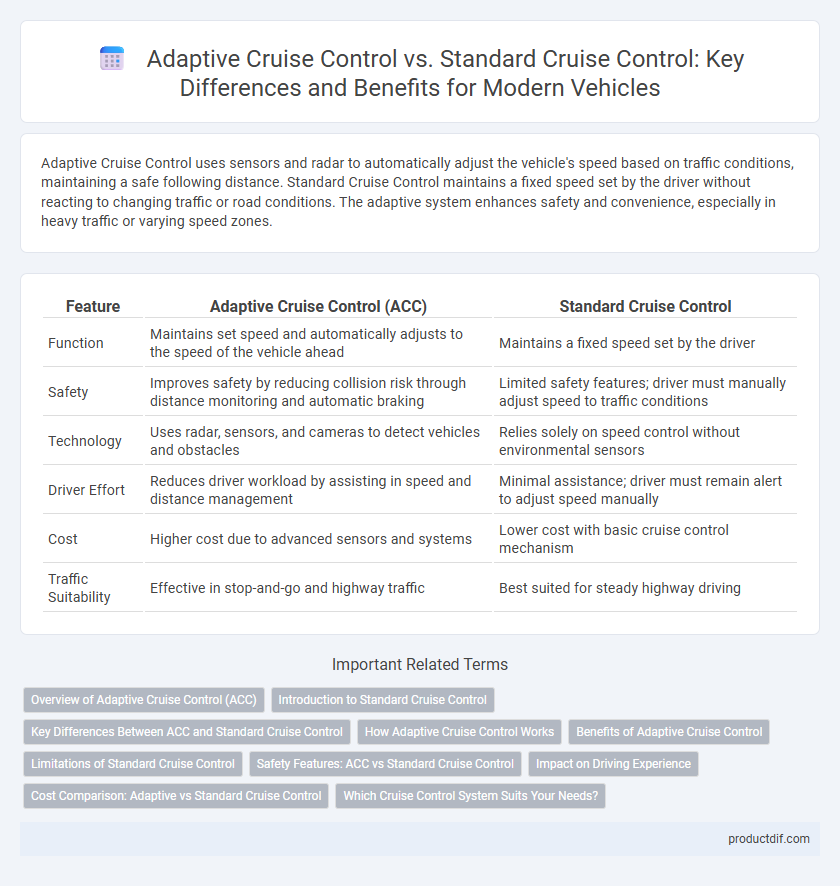Adaptive Cruise Control uses sensors and radar to automatically adjust the vehicle's speed based on traffic conditions, maintaining a safe following distance. Standard Cruise Control maintains a fixed speed set by the driver without reacting to changing traffic or road conditions. The adaptive system enhances safety and convenience, especially in heavy traffic or varying speed zones.
Table of Comparison
| Feature | Adaptive Cruise Control (ACC) | Standard Cruise Control |
|---|---|---|
| Function | Maintains set speed and automatically adjusts to the speed of the vehicle ahead | Maintains a fixed speed set by the driver |
| Safety | Improves safety by reducing collision risk through distance monitoring and automatic braking | Limited safety features; driver must manually adjust speed to traffic conditions |
| Technology | Uses radar, sensors, and cameras to detect vehicles and obstacles | Relies solely on speed control without environmental sensors |
| Driver Effort | Reduces driver workload by assisting in speed and distance management | Minimal assistance; driver must remain alert to adjust speed manually |
| Cost | Higher cost due to advanced sensors and systems | Lower cost with basic cruise control mechanism |
| Traffic Suitability | Effective in stop-and-go and highway traffic | Best suited for steady highway driving |
Overview of Adaptive Cruise Control (ACC)
Adaptive Cruise Control (ACC) is an advanced driver-assistance system that automatically adjusts a vehicle's speed to maintain a safe distance from preceding vehicles using radar and sensors. Unlike standard cruise control, which maintains a fixed speed, ACC dynamically responds to traffic conditions, enhancing safety and reducing driver fatigue. This technology improves road safety by minimizing the risk of rear-end collisions through real-time speed adjustments.
Introduction to Standard Cruise Control
Standard cruise control maintains a constant vehicle speed set by the driver without manual acceleration input, primarily using the throttle control system. Unlike adaptive cruise control, it does not automatically adjust speed based on traffic conditions or maintain a safe following distance. Standard cruise control enhances highway driving comfort but requires driver intervention for speed changes and braking.
Key Differences Between ACC and Standard Cruise Control
Adaptive Cruise Control (ACC) differentiates itself from standard cruise control by automatically adjusting the vehicle's speed to maintain a safe following distance using radar or cameras. While standard cruise control maintains a fixed speed set by the driver, ACC dynamically responds to traffic conditions, slowing down or accelerating as necessary. This smart technology enhances driving comfort and safety by reducing the need for manual speed adjustments in varying traffic situations.
How Adaptive Cruise Control Works
Adaptive Cruise Control uses radar and cameras to monitor the distance between your vehicle and the one ahead, automatically adjusting the speed to maintain a safe following distance. This system can decelerate and accelerate without driver input, enhancing safety and convenience in traffic. Standard Cruise Control maintains a set speed without accounting for surrounding vehicles, lacking the dynamic speed adjustment feature found in Adaptive Cruise Control.
Benefits of Adaptive Cruise Control
Adaptive Cruise Control (ACC) enhances driving safety by automatically adjusting vehicle speed to maintain a safe following distance from the car ahead, reducing the risk of collisions in varying traffic conditions. Unlike standard cruise control, which only maintains a preset speed, ACC can respond to changes in traffic flow, providing smoother acceleration and deceleration that improve fuel efficiency and lessen driver fatigue. This advanced technology also supports stop-and-go traffic situations, making highway driving more comfortable and reducing stress on long trips.
Limitations of Standard Cruise Control
Standard Cruise Control lacks the ability to adjust speed based on traffic conditions, often requiring manual braking and acceleration in stop-and-go traffic. It does not detect obstacles or maintain safe following distances, increasing the risk of collisions during sudden changes in road situations. This limitation reduces convenience and safety compared to Adaptive Cruise Control, which dynamically adapts speed for varying traffic flows.
Safety Features: ACC vs Standard Cruise Control
Adaptive Cruise Control (ACC) enhances vehicle safety by automatically adjusting speed based on traffic conditions, maintaining a safe following distance using sensors and radar technology. Standard Cruise Control maintains a fixed speed set by the driver without accounting for surrounding traffic or obstacles, increasing the risk of collisions in dynamic driving environments. ACC's advanced safety features reduce driver fatigue and improve reaction times by actively managing speed and distance on highways.
Impact on Driving Experience
Adaptive Cruise Control (ACC) enhances the driving experience by automatically adjusting vehicle speed to maintain a safe following distance, reducing the need for constant manual speed adjustments. Standard Cruise Control maintains a fixed speed set by the driver, which can be less efficient in varying traffic conditions and may require frequent braking or acceleration. ACC improves comfort and safety during long drives, especially in stop-and-go traffic, by responding dynamically to surrounding vehicles.
Cost Comparison: Adaptive vs Standard Cruise Control
Adaptive Cruise Control (ACC) systems typically cost between $500 and $2,500 more than Standard Cruise Control due to advanced sensors and radar technology. Installation and maintenance expenses for ACC are higher, reflecting the complexity of features like automatic speed adjustment and collision avoidance. Standard Cruise Control remains a more affordable option for basic speed regulation without adaptive safety enhancements.
Which Cruise Control System Suits Your Needs?
Adaptive Cruise Control (ACC) automatically adjusts your vehicle's speed by detecting traffic conditions, providing enhanced safety and convenience in varying traffic flows, while Standard Cruise Control maintains a fixed speed set by the driver without responding to changing road situations. ACC suits drivers frequently navigating heavy traffic or highway congestion, offering smoother and more responsive control that reduces fatigue. Standard Cruise Control is ideal for consistent-speed driving on open roads, where minimal speed adjustments are needed, prioritizing simplicity and cost-effectiveness.
Adaptive Cruise Control vs Standard Cruise Control Infographic

 productdif.com
productdif.com